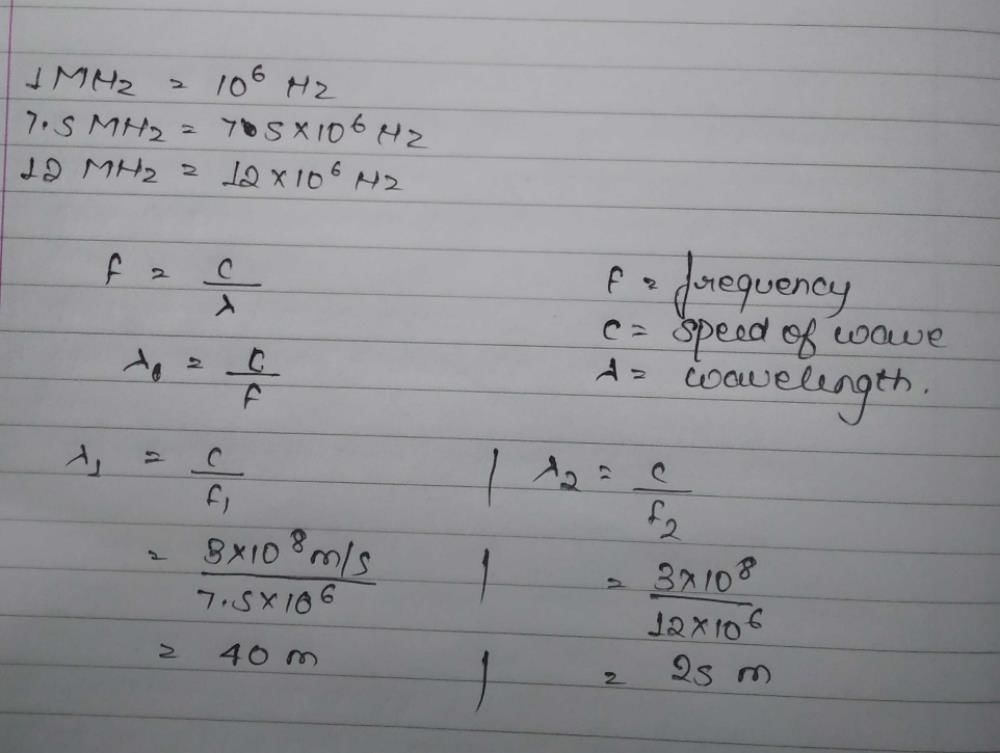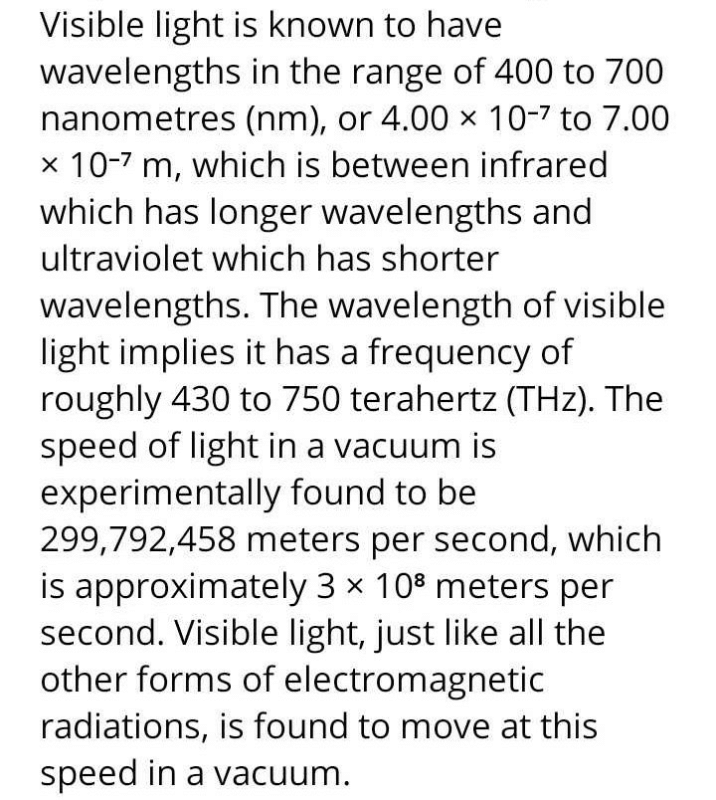All Exams >
JAMB >
Physics for JAMB >
All Questions
All questions of Waves for JAMB Exam
A sound source of frequency 600 Hz is moving towards an observer with velocity 20m/s. The speed of sound is 340m/s. The frequency heard by observer will be- a)630.5hz
- b)30hz
- c)637.5hz
- d)63.5 Hz
Correct answer is option 'C'. Can you explain this answer?
A sound source of frequency 600 Hz is moving towards an observer with velocity 20m/s. The speed of sound is 340m/s. The frequency heard by observer will be
a)
630.5hz
b)
30hz
c)
637.5hz
d)
63.5 Hz
|
|
Preeti Khanna answered |
F(s)/F(l) = [V+V(s)]/[V+V(l)]
V = velocity of sound = 340m/s
V(l) = velocity of listener = 0
F(l) = frequency heard by listener = ?
V(s) = velocity of source = -20m/s (because, it's source to listener)
F(s) = frequency of source = 600hz
By putting these values in the above formula and solving we get,
F(l) = 637.5 Hz.
Hence C is correct.
V = velocity of sound = 340m/s
V(l) = velocity of listener = 0
F(l) = frequency heard by listener = ?
V(s) = velocity of source = -20m/s (because, it's source to listener)
F(s) = frequency of source = 600hz
By putting these values in the above formula and solving we get,
F(l) = 637.5 Hz.
Hence C is correct.
Which region in the electromagnetic spectrum will have the highest speed?- a)Radio
- b)Visible
- c)All the regions have same speed
- d)Microwaves
Correct answer is option 'C'. Can you explain this answer?
Which region in the electromagnetic spectrum will have the highest speed?
a)
Radio
b)
Visible
c)
All the regions have same speed
d)
Microwaves
|
|
Alok Mehta answered |
The entire electromagnetic spectrum, from the lowest to the highest frequency (longest to shortest wavelength), includes all radio waves (e.g., commercial radio and television, microwaves, radar), infrared radiation, visible light, ultraviolet radiation, X-rays, and gamma rays.
The speed of electromagnetic waves in free space is given by  .
.
Here μ0 is ___________and ε0 is ________________ of free space.- a)permittivity, permeability
- b)coercivity, permeability
- c)permeability, susceptibility
- d)permeability, permittivity
Correct answer is option 'A'. Can you explain this answer?
The speed of electromagnetic waves in free space is given by  .
.
Here μ0 is ___________and ε0 is ________________ of free space.
Here μ0 is ___________and ε0 is ________________ of free space.
a)
permittivity, permeability
b)
coercivity, permeability
c)
permeability, susceptibility
d)
permeability, permittivity
|
|
Prateek Jain answered |
μ0 is called the permittivity of free space and similarly, ε0 is called the permeability of free space.
A cylindrical tube, open at both ends, has a fundamental frequency f in air. The tube is dipped vertically in water so that half of it is in water. The fundamental frequency of the air-column is now:- a)f/2
- b)f
- c)2f
- d)3f/2
Correct answer is option 'B'. Can you explain this answer?
A cylindrical tube, open at both ends, has a fundamental frequency f in air. The tube is dipped vertically in water so that half of it is in water. The fundamental frequency of the air-column is now:
a)
f/2
b)
f
c)
2f
d)
3f/2
|
|
Krishna Iyer answered |
As we know, f=v/2l
Now, it will act as one end and one end closed.
So, f0=v/2l’=v/4½=v/2l=f
Now, it will act as one end and one end closed.
So, f0=v/2l’=v/4½=v/2l=f
Phenomenon of beats is not used in- a)Tuning musical instruments
- b)Detecting the presence of dangerous gases in mines
- c)Designing low frequency oscillators
- d)Radars for detecting submarines
Correct answer is option 'D'. Can you explain this answer?
Phenomenon of beats is not used in
a)
Tuning musical instruments
b)
Detecting the presence of dangerous gases in mines
c)
Designing low frequency oscillators
d)
Radars for detecting submarines

|
Top Rankers answered |
Radar uses electromagnetic energy pulses. The radio-frequency (rf) energy is transmitted to and reflected from the reflecting object. A small portion of the reflected energy returns to the radar set. This returned energy is called an ECHO. Radar sets use the echo to determine the direction and distance of the reflecting object.
It does not work on phenomena of beats.
It does not work on phenomena of beats.
As a wave propagates; which of the following is not satisfied?- a)the wave intensity remains constant for a plane wave
- b)total intensity of the spherical wave over the spherical surface centered at the source remains constant at all times
- c)the wave intensity decreases as the inverse of the square of the distance from the source for a spherical wave
- d)the wave intensity decreases as the inverse of the distance from the source for a spherical wave
Correct answer is option 'D'. Can you explain this answer?
As a wave propagates; which of the following is not satisfied?
a)
the wave intensity remains constant for a plane wave
b)
total intensity of the spherical wave over the spherical surface centered at the source remains constant at all times
c)
the wave intensity decreases as the inverse of the square of the distance from the source for a spherical wave
d)
the wave intensity decreases as the inverse of the distance from the source for a spherical wave
|
|
Shatabdi Malik answered |
I think it's ans is C.
Pure sound notes from two sources make the molecules of air at a location vibrate simple harmonically in accordance with the equations.
y1 = 0.008 sin (604 n t) and
y2 = 0.007 sin (610 n t) respectively.
The number of beast heard by a person at the location will be:- a)3
- b)1
- c)2
- d)4
Correct answer is option 'A'. Can you explain this answer?
Pure sound notes from two sources make the molecules of air at a location vibrate simple harmonically in accordance with the equations.
y1 = 0.008 sin (604 n t) and
y2 = 0.007 sin (610 n t) respectively.
The number of beast heard by a person at the location will be:
y1 = 0.008 sin (604 n t) and
y2 = 0.007 sin (610 n t) respectively.
The number of beast heard by a person at the location will be:
a)
3
b)
1
c)
2
d)
4

|
Tarun Kaushik answered |
Given that two sources produce pure sound notes as follows: y1= 0.008 sin (604 n t) y2= 0.007 sin (610 n t) To find the number of beats heard by a person at the location, we need to first understand the concept of beats.
Beats: When two sound waves of slightly different frequencies are superimposed, we hear a periodic variation in the loudness of sound. This variation is called beats.
The number of beats heard per second is given by the difference between the frequencies of the two sound waves.
Mathematically, the beat frequency is given by fbeat = |f1 - f2| where f1 and f2 are the frequencies of the two sound waves. In this problem, the frequencies of the two sound waves are 604 n and 610 n, respectively.
Therefore, the beat frequency is fbeat = |604 n - 610 n| = 6 n Since the beat frequency is 6 n, the number of beats heard per second is 6. Since each beat corresponds to two sound waves (one from each source), the total number of sound waves heard per second is twice the number of beats, which is 12.
However, the question asks for the number of distinct sounds heard, which is equal to the number of beats. Therefore, the answer is 3 (Option A).
Light of wavelength 500 nm is incident on a slit o... moref width 0.1 mm. The width of the central bright line on the screen is 2m. What is the distance of the screen?a)1 mb)200 mc)0.75 md)0.5 mCorrect answer is option 'B'. Can you explain this answer?
|
|
Swara Sharma answered |
Beta(central Maxima)=2lambda D(distance of the screen)/d(distance between slits).
beta=2m.
wavelength= 500nm=5×10^-7m.
d=0.1mm=1×10^-4m.
2=2×5×10^-7 D/10^-4.
1=5×10^-3 D .
1/5×10^-3=D .
1000/5=D.
200m=D
beta=2m.
wavelength= 500nm=5×10^-7m.
d=0.1mm=1×10^-4m.
2=2×5×10^-7 D/10^-4.
1=5×10^-3 D .
1/5×10^-3=D .
1000/5=D.
200m=D
Which region in the electromagnetic spectrum has the highest frequency?- a)Frequency is same for the complete spectrum
- b)Gamma Radiation Region
- c)Radio
- d)Visible
Correct answer is option 'B'. Can you explain this answer?
Which region in the electromagnetic spectrum has the highest frequency?
a)
Frequency is same for the complete spectrum
b)
Gamma Radiation Region
c)
Radio
d)
Visible

|
Shaik Khaja Azeem Ali answered |
A gamma ray or gamma radiation is a penetrating electromagnetic radiation arising from the radioactive decay of atomic nuclei. It consists of the shortest wavelength electromagnetic waves and so imparts the highest photon energy
The electric field for an em wave is: E = E0sin[(12 x 1015 t – 4 x 107 x)]. What is the speed of the em waves?- a)48 x 108 m / s
- b)3 x 108 m / s
- c)4 x 107 m / s
- d)12 x 1015 m / s
Correct answer is option 'B'. Can you explain this answer?
The electric field for an em wave is: E = E0sin[(12 x 1015 t – 4 x 107 x)]. What is the speed of the em waves?
a)
48 x 108 m / s
b)
3 x 108 m / s
c)
4 x 107 m / s
d)
12 x 1015 m / s
|
|
Hansa Sharma answered |
V(velocity/speed)= ω/wave number (K)
V= 12×1015/4×107
V=3×108 m/s
V= 12×1015/4×107
V=3×108 m/s
Which colour of the visible spectrum has the greatest wavelength?- a)Blue
- b)Yellow
- c)Red
- d)Violet
Correct answer is option 'C'. Can you explain this answer?
Which colour of the visible spectrum has the greatest wavelength?
a)
Blue
b)
Yellow
c)
Red
d)
Violet
|
|
Shreya Singh answered |
Violet ---→greatest frequency.....
Red------→greatest wavelength...
Red------→greatest wavelength...
Which of the following is not an example of coherent source produced by the division of wavefront?- a)Fresnel’s biprism
- b)Lloyd’s mirror
- c)Young’s double slit experiment
- d)Interference by thin films
Correct answer is option 'D'. Can you explain this answer?
Which of the following is not an example of coherent source produced by the division of wavefront?
a)
Fresnel’s biprism
b)
Lloyd’s mirror
c)
Young’s double slit experiment
d)
Interference by thin films
|
|
Suresh Iyer answered |
The correct answer is option D
In A,B,C there is a single source (coherent source)while in D there is an interference of thin films whose sources are different ,therefore not coherent.
In A,B,C there is a single source (coherent source)while in D there is an interference of thin films whose sources are different ,therefore not coherent.
If the Young’s apparatus is immersed in water, the effect on fringe width will- a)remain same
- b)decrease
- c)increase
- d)Cant say because the experiment cannot be carried in any other medium except air
Correct answer is option 'B'. Can you explain this answer?
If the Young’s apparatus is immersed in water, the effect on fringe width will
a)
remain same
b)
decrease
c)
increase
d)
Cant say because the experiment cannot be carried in any other medium except air
|
|
Kalyan Joshi answered |
Effect of Immersing Young's Apparatus in Water on Fringe Width
When the Young's apparatus is immersed in water, the effect on the fringe width can be explained as follows:
1. Refractive Index of Water: Water has a higher refractive index than air. This means that light passing through water will be bent more than in air.
2. Path Difference: Path difference is the difference in the distance traveled by two waves from the source to the point where they interfere with each other. When the apparatus is immersed in water, the path difference between the two waves will change due to the change in refractive index.
3. Decrease in Fringe Width: As the path difference changes, the interference pattern will also change. The fringe width will decrease because the change in the path difference will cause the interference pattern to become more spread out.
4. Explanation: The fringe width is inversely proportional to the square root of the refractive index. Since the refractive index of water is higher than air, the fringe width will decrease when the apparatus is immersed in water.
Conclusion
In conclusion, when the Young's apparatus is immersed in water, the fringe width will decrease due to the change in refractive index, which leads to a change in the path difference and the interference pattern.
When the Young's apparatus is immersed in water, the effect on the fringe width can be explained as follows:
1. Refractive Index of Water: Water has a higher refractive index than air. This means that light passing through water will be bent more than in air.
2. Path Difference: Path difference is the difference in the distance traveled by two waves from the source to the point where they interfere with each other. When the apparatus is immersed in water, the path difference between the two waves will change due to the change in refractive index.
3. Decrease in Fringe Width: As the path difference changes, the interference pattern will also change. The fringe width will decrease because the change in the path difference will cause the interference pattern to become more spread out.
4. Explanation: The fringe width is inversely proportional to the square root of the refractive index. Since the refractive index of water is higher than air, the fringe width will decrease when the apparatus is immersed in water.
Conclusion
In conclusion, when the Young's apparatus is immersed in water, the fringe width will decrease due to the change in refractive index, which leads to a change in the path difference and the interference pattern.
A rotating calcite crystal is placed over an ink dot. On seeing through the crystal one finds:- a)Two stationary dots
- b)Two dots moving along straight lines
- c)One dot rotating about the other
- d)Both dots rotating about a common axis
Correct answer is option 'C'. Can you explain this answer?
A rotating calcite crystal is placed over an ink dot. On seeing through the crystal one finds:
a)
Two stationary dots
b)
Two dots moving along straight lines
c)
One dot rotating about the other
d)
Both dots rotating about a common axis
|
|
Anaya Patel answered |
In calcite crystal there is a phenomenon of double refraction. So, we see one dot as a stationary object whereas the other being refracted at a little displaced position seems to be rotating about the first dot.
An unpolarised beam of intensity Io is incident on a polarizer and analyser placed in contact. The angle between the transmission axes of the polarizer and the analyser is θ. What is the intensity of light emerging out of the analyser?- a)(I0 cos 2θ)/2
- b)I0 cos2θ
- c)I0 cosθ
- d)I0
Correct answer is option 'A'. Can you explain this answer?
An unpolarised beam of intensity Io is incident on a polarizer and analyser placed in contact. The angle between the transmission axes of the polarizer and the analyser is θ. What is the intensity of light emerging out of the analyser?
a)
(I0 cos 2θ)/2
b)
I0 cos2θ
c)
I0 cosθ
d)
I0
|
|
Nikita Singh answered |
Suppose the angle between the transmission axes of the analyser and the polarizer is θ. The completely plane polarized light form the polarizer is incident on the analyser. If E0 is the amplitude of the electric vector transmitted by the polarizer, then intensity I0 of the light incident on the analyser is
I ∞ E02
The electric field vector E0 can be resolved into two rectangular components i.e E0 cosθ and E0 sinθ. The analyzer will transmit only the component ( i.e E0 cosθ ) which is parallel to its transmission axis. However, the component E0sinθ will be absorbed by the analyser. Therefore, the intensity I of light transmitted by the analyzer is,
I ∞ ( E0 x cosθ )2
I / I0 = ( E0 x cosθ )2 / E02 = cos2θ
I = I0 x cos2θ
when light passes from polarizer it's intensity becomes half and when passed through analyser it becomes,
I = I0 x cos2θ/2
I ∞ E02
The electric field vector E0 can be resolved into two rectangular components i.e E0 cosθ and E0 sinθ. The analyzer will transmit only the component ( i.e E0 cosθ ) which is parallel to its transmission axis. However, the component E0sinθ will be absorbed by the analyser. Therefore, the intensity I of light transmitted by the analyzer is,
I ∞ ( E0 x cosθ )2
I / I0 = ( E0 x cosθ )2 / E02 = cos2θ
I = I0 x cos2θ
when light passes from polarizer it's intensity becomes half and when passed through analyser it becomes,
I = I0 x cos2θ/2
Infrared waves are produced by- a)Permanent magnets
- b)dipole oscillations
- c)static charges
- d)all hot bodies and molecules
Correct answer is option 'D'. Can you explain this answer?
Infrared waves are produced by
a)
Permanent magnets
b)
dipole oscillations
c)
static charges
d)
all hot bodies and molecules
|
|
Yashika Singh answered |
Option(d)becoz--->
infrared radiation is heat or thermal radiation, any object which has a temperature radiates in the infrared. Even objects that we think of as being very cold, such as an ice cube, emit infrared. When an object is not quite hot enough to radiate visible light, it will emit most of its energy in the infrared
An echo repeats two syllables. If the velocity of sound is 330 m/s, then the distance of reflecting surface is- a)16.5 m
- b)99 m
- c)66 m
- d)33.0 m
Correct answer is option 'C'. Can you explain this answer?
An echo repeats two syllables. If the velocity of sound is 330 m/s, then the distance of reflecting surface is
a)
16.5 m
b)
99 m
c)
66 m
d)
33.0 m
|
|
Rajesh Gupta answered |
Let us say that we speak syllables at a rate of 2 to 9 per second. So let us say that a syllable takes a minimum of 0.1 sec for a fast speaker. Let us say that a sound pulse (syllable) is emitted starting at t = 0.
The effect of a syllable lasts on the ear for 0.1 sec. So if any echo reaches the year before t = 0.2 sec., then it is mixed with the direct sound present in the ear and so echo is not properly heard.
In this problem, two syllables are repeated in the echo. That is it took about 2 * 0.2 sec ie., 0.4 seconds for the sound to travel to the reflecting surface and come back to the ear.
The distance of the reflecting surface from the person
= 330 m/s * 0.4 sec / 2
= 66 meters.
Two coherent sources produce a dark fringe when phase difference between the interfering waves is(n integer)- a)2π
- b)(2n – 1)π
- c)zero
- d)n
Correct answer is option 'B'. Can you explain this answer?
Two coherent sources produce a dark fringe when phase difference between the interfering waves is(n integer)
a)
2π
b)
(2n – 1)π
c)
zero
d)
n
|
|
Shruti Sarkar answered |
Dark fringes will be produced when there are destructive interference. The condition for that is the two waves should have a phase difference of an odd integral multiple of π.
A beam of light has a wavelength of 650 nm in vacuum. What is the wavelength of these waves in the liquid whose index of refraction at this wavelength is 1.47?- a)472nm
- b)442nm
- c)462nm
- d)452nm
Correct answer is option 'B'. Can you explain this answer?
A beam of light has a wavelength of 650 nm in vacuum. What is the wavelength of these waves in the liquid whose index of refraction at this wavelength is 1.47?
a)
472nm
b)
442nm
c)
462nm
d)
452nm
|
|
Geetika Shah answered |
We know that,
Wavelength of light in a material:
λ= λ0/n
where, λ=wavelength of material, λ0=wavelength of light in vacuum,
n=index of refraction of material.
So, 650x10-9m/1.47=442.177nm.
Wavelength of light in a material:
λ= λ0/n
where, λ=wavelength of material, λ0=wavelength of light in vacuum,
n=index of refraction of material.
So, 650x10-9m/1.47=442.177nm.
Diffraction of light gives the information of- a)Transverse nature
- b)Longitudinal nature
- c)Both transverse and longitudinal
- d)Neither transverse nor longitudina
Correct answer is option 'D'. Can you explain this answer?
Diffraction of light gives the information of
a)
Transverse nature
b)
Longitudinal nature
c)
Both transverse and longitudinal
d)
Neither transverse nor longitudina
|
|
Vijay Bansal answered |
Transverse and longitudinal waves. Light and other types of electromagnetic radiation are transverse waves. Water waves and S waves (a type of seismic wave) are also transverse waves. In transverse waves, the vibrations are at right angles to the direction of travel.
Diffraction pattern cannot be observed with:a)one wide slitb)two narrow slitsc)one narrow slitd)large number of narrow slitsCorrect answer is option 'A'. Can you explain this answer?
|
|
Pooja Mehta answered |
If one illuminates two parallel slits, the light from the two slits again interferes. Here the interference is a more pronounced pattern with a series of alternating light and dark bands. ... He also proposed (as a thought experiment) that if detectors were placed before each slit, the interference pattern would disappear.
In an experiment to find the speed of waves in a rope, a standing wave pattern is established as shown in diagram below. The vibrating end of rope makes 90 vibrations per minute. The speed of the waves is

- a)4 m/s
- b)3 m/s
- c)6 m/s
- d)2 m/s
Correct answer is 'C'. Can you explain this answer?
In an experiment to find the speed of waves in a rope, a standing wave pattern is established as shown in diagram below. The vibrating end of rope makes 90 vibrations per minute. The speed of the waves is


a)
4 m/s
b)
3 m/s
c)
6 m/s
d)
2 m/s
|
|
Anjana Sharma answered |
90 vibrations in 60 seconds mans _frequency, f =1.5Hz
According to diagram1.5 Hz is covered in 6m wavelength, ω = 4m
We have qmed ,v = f x ω = 1.5 x 4 = 6m/s
Which one is not an electromagnetic wave?- a)ultraviolet rays
- b)ultrasound waves
- c)X- rays
- d)radio waves
Correct answer is option 'B'. Can you explain this answer?
Which one is not an electromagnetic wave?
a)
ultraviolet rays
b)
ultrasound waves
c)
X- rays
d)
radio waves
|
|
Shivaraju. K Shivaraju. answered |
These are not audible because high frequency wave
Weather forecasting uses- a)Visible Rays
- b)Micro waves
- c)Infra red Rays
- d)Gamma Rays
Correct answer is option 'C'. Can you explain this answer?
Weather forecasting uses
a)
Visible Rays
b)
Micro waves
c)
Infra red Rays
d)
Gamma Rays
|
|
Nandini Iyer answered |
It's an infrared sensor that reads temperatures.This sensor allows satellites to measure the amount of energy radiated by Earth's surface, clouds, oceans, air, and so on. Infrared sensors can be used at night—a helpful feature for forecasters, considering that the imager can only pick up data during daylight hours.
In a single slit experiment, suppose the slit width is equal to the wavelength of light used. Then- a)Slit image becomes very small
- b)The image of the slit becomes infinitely wide
- c)Diffraction effect cannot be observed
- d)Diffraction pattern becomes wider
Correct answer is option 'B'. Can you explain this answer?
In a single slit experiment, suppose the slit width is equal to the wavelength of light used. Then
a)
Slit image becomes very small
b)
The image of the slit becomes infinitely wide
c)
Diffraction effect cannot be observed
d)
Diffraction pattern becomes wider
|
|
Om Desai answered |
This is because for maximum diffraction the slit width always equals to the wavelength of light.
The phenomena diffraction can take place in sound waves.- a)Yes
- b)No
- c)Only Interference
- d)Under certain conditions only
Correct answer is option 'A'. Can you explain this answer?
The phenomena diffraction can take place in sound waves.
a)
Yes
b)
No
c)
Only Interference
d)
Under certain conditions only
|
|
Rohan Singh answered |
YES, Sound waves, on the other hand, are longitudinal, meaning that they oscillate parallel to the direction of their motion. Since there is no component of a sound wave's oscillation that is perpendicular to its motion, sound waves cannot be polarized
A stationary observer receives sonic oscillations from two tuning forks, one of which approaches and the other recedes with same speed. As this takes place the observer hears the beat frequency of 2 Hz. Find the speed of each tuning fork,(assuming it is very small when compared to sound) if their oscillation frequency is 680 Hz and the velocity of sound in air is 340 m/s. - a)1 m/s
- b)2 m/s
- c)0.5 m/s
- d)1.5 m/s
Correct answer is option 'C'. Can you explain this answer?
A stationary observer receives sonic oscillations from two tuning forks, one of which approaches and the other recedes with same speed. As this takes place the observer hears the beat frequency of 2 Hz. Find the speed of each tuning fork,(assuming it is very small when compared to sound) if their oscillation frequency is 680 Hz and the velocity of sound in air is 340 m/s.
a)
1 m/s
b)
2 m/s
c)
0.5 m/s
d)
1.5 m/s
|
|
Lavanya Menon answered |
Let the frequencies be f1 and f2
So, f1 = f (vs/vs - v) and f2 = f (vs/vs + v)
ATQ: f1 – f2 = 2 Hz
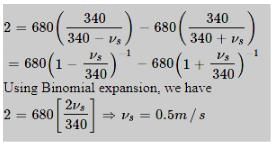
So, f1 = f (vs/vs - v) and f2 = f (vs/vs + v)
ATQ: f1 – f2 = 2 Hz

Fundamental note in open pipe (v1=ν/2L) has _________ the frequency of the fundamental note in closed organ pipe (v2=ν/4L).a)Twiceb)Halfc)Four timesd)ThriceCorrect answer is option 'A'. Can you explain this answer?
|
|
Riya Banerjee answered |
Let L be a length of the pipe,
The fundamental frequency of closed pipe is
v2=ν/4L .....(i)
where ν is the speed of sound in air.
Fundamental frequency of open pipe of same length is
v1=ν/2L .....(ii)
After dividing v1 with v2,
v1/v2= ν/2L/ ν/4L
v1=2v2
The fundamental frequency of closed pipe is
v2=ν/4L .....(i)
where ν is the speed of sound in air.
Fundamental frequency of open pipe of same length is
v1=ν/2L .....(ii)
After dividing v1 with v2,
v1/v2= ν/2L/ ν/4L
v1=2v2
Which of the following is not a use of electromagnetic wave?- a)In detection of invisible writing
- b)In global warming
- c)In greenhouses to keep plants warm
- d)In warfare for looking through mist and fog
Correct answer is option 'B'. Can you explain this answer?
Which of the following is not a use of electromagnetic wave?
a)
In detection of invisible writing
b)
In global warming
c)
In greenhouses to keep plants warm
d)
In warfare for looking through mist and fog
|
|
User5881746 answered |
Electromagnetic waves are not used to determine the global warming
Which of the following undergoes largest diffraction?- a)Ultraviolet light
- b)Infra red light
- c)Radio waves
- d)Y – rays
Correct answer is option 'C'. Can you explain this answer?
Which of the following undergoes largest diffraction?
a)
Ultraviolet light
b)
Infra red light
c)
Radio waves
d)
Y – rays
|
|
Anjana Sharma answered |
Maximum diffraction occurs when size of obstacle is almost equal to wavelength of light wave. Hence maximum diffraction occurs for larger wavelength . As wavelength of radio wave is higher than others, maximum diffraction will occur for it.
When two tuning forks are sounded together 4 beats are heard per second. One tuning fork is of frequency 346 Hz. When its prong is loaded with a little wax, the number of beats is increased to 6 per second. The frequency of the other fork is:- a)352 Hz
- b)340 Hz
- c)350 Hz
- d)342 Hz
Correct answer is option 'C'. Can you explain this answer?
When two tuning forks are sounded together 4 beats are heard per second. One tuning fork is of frequency 346 Hz. When its prong is loaded with a little wax, the number of beats is increased to 6 per second. The frequency of the other fork is:
a)
352 Hz
b)
340 Hz
c)
350 Hz
d)
342 Hz
|
|
Suresh Reddy answered |
Frequency of fork one is 346 Hz.
When the other fork is waxed, the beat is increased.
So, the frequency of other fork is less than the frequency of fork one.
So,
beat = frequency of fork one − frequency of second fork
4=346− Frequency of second fork
Frequency of second fork =350 Hz
When the other fork is waxed, the beat is increased.
So, the frequency of other fork is less than the frequency of fork one.
So,
beat = frequency of fork one − frequency of second fork
4=346− Frequency of second fork
Frequency of second fork =350 Hz
Young’s double slit experiment is carried out using two bulbs instead of using two slits and one source. Then- a)Fringes will be elliptical
- b)No interference fringes will be observed
- c)Fringes will be dark
- d)The interference fringes will be colored
Correct answer is option 'B'. Can you explain this answer?
Young’s double slit experiment is carried out using two bulbs instead of using two slits and one source. Then
a)
Fringes will be elliptical
b)
No interference fringes will be observed
c)
Fringes will be dark
d)
The interference fringes will be colored
|
|
Rajesh Gupta answered |
We observe interference pattern when the size of the slits are comparable to the wavelength of light. But here, the size of the bulb is bigger than wavelength of light.
Do EM waves need a medium to travel through?- a)No
- b)Yes
- c)ether is required
- d)None of the above
Correct answer is option 'A'. Can you explain this answer?
Do EM waves need a medium to travel through?
a)
No
b)
Yes
c)
ether is required
d)
None of the above
|
|
Gopikas S answered |
The electromagnetic waves are not mechanical waves. There are vibrations of electric vector and magnetic vector in them. These vibrations do not need any particles present in the medium for their propagation. That's why electromagnetic waves do not require any medium for propagation.
The speed of propagation of a sinusoidal wave is given by V=νλ where- a)ν is the reciprocal of the period and λ is the dispersion
- b)ν is the reciprocal of the period and λ is the wave number
- c)ν is the angular frequency and λ is the wavelength
- d)ν is the reciprocal of the period and λ is the wavelength
Correct answer is option 'D'. Can you explain this answer?
The speed of propagation of a sinusoidal wave is given by V=νλ where
a)
ν is the reciprocal of the period and λ is the dispersion
b)
ν is the reciprocal of the period and λ is the wave number
c)
ν is the angular frequency and λ is the wavelength
d)
ν is the reciprocal of the period and λ is the wavelength
|
|
Om Desai answered |
For a sinusoidal wave, V = v λ.
V = speed,
v = frequency,
λ = wavelength,
frequency (v) = reciprocal of the time period i.e. v =1/T
V = speed,
v = frequency,
λ = wavelength,
frequency (v) = reciprocal of the time period i.e. v =1/T
A ray of light strikes a glass plate at an angle of 60°. If the reflected and refracted rays are perpendicular to each other, then refractive index of glass is- a)3/2
- b)√3
- c)√3/2
- d)1/2
Correct answer is option 'B'. Can you explain this answer?
A ray of light strikes a glass plate at an angle of 60°. If the reflected and refracted rays are perpendicular to each other, then refractive index of glass is
a)
3/2
b)
√3
c)
√3/2
d)
1/2
|
|
Hansa Sharma answered |
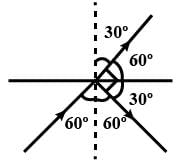
Given from figure angle of incidence i=600
angle of refraction r=300
We know μ= sin i/sin r
μ= sin60/sin30 =((√3)/2) ×2=√3
To the nearest order of magnitude, how many times greater than the speed of sound is the speed of light?- a)104
- b)1012
- c)108
- d)106
Correct answer is option 'D'. Can you explain this answer?
To the nearest order of magnitude, how many times greater than the speed of sound is the speed of light?
a)
104
b)
1012
c)
108
d)
106
|
|
Lavanya Menon answered |
Speed of sound in air is 343 m/s or we can say approx 300m/s
And speed of light is approx 300,000,000 m/s
Clearly the ratio is 106
And speed of light is approx 300,000,000 m/s
Clearly the ratio is 106
At t= 0, a transverse wave pulse travelling in the positive x direction with a speed of 2 m/s in a wire is described by the function y = 6/x2 given that x ≠ 0. Transverse velocity of a particle at x = 2 m and t = 2 s is - a)3 m/s
- b)-3 m/s
- c)8 m/s
- d)-8 m/s
Correct answer is option 'B'. Can you explain this answer?
At t= 0, a transverse wave pulse travelling in the positive x direction with a speed of 2 m/s in a wire is described by the function y = 6/x2 given that x ≠ 0. Transverse velocity of a particle at x = 2 m and t = 2 s is
a)
3 m/s
b)
-3 m/s
c)
8 m/s
d)
-8 m/s
|
|
Preeti Khanna answered |
Any transverse wave travelling in positive x-direction is of the form y = f (ax - bt) (and y = f (ax + bt) if it is travelling in negative x-direction) and has a wave speed equal to b/a.
Given a = 1 ⇒ b = 2
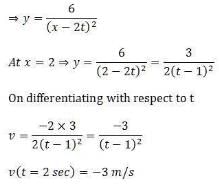
Given a = 1 ⇒ b = 2

Two plane mirrors intersect at right angles. A laser beam strikes the first of them at a point 11.5 cm from their point of intersection, as shown in figure For what angle of incidence at the first mirror will this ray strike the midpoint of the second mirror (which is 28.0 cm long) after reflecting from the first mirror? 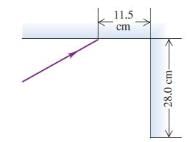
- a)41.4∘
- b)42.4∘
- c)40.4∘
- d)39.4∘
Correct answer is option 'D'. Can you explain this answer?
Two plane mirrors intersect at right angles. A laser beam strikes the first of them at a point 11.5 cm from their point of intersection, as shown in figure For what angle of incidence at the first mirror will this ray strike the midpoint of the second mirror (which is 28.0 cm long) after reflecting from the first mirror?

a)
41.4∘
b)
42.4∘
c)
40.4∘
d)
39.4∘
|
|
Riya Banerjee answered |
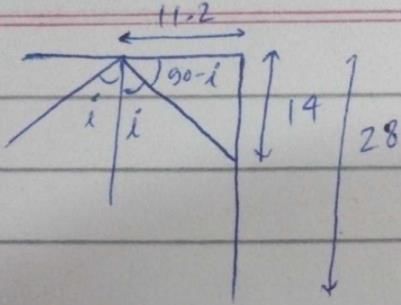
Tan(90-i)=14/11.2
Cot i=14/11.2
I=cot-1(14/11.2)
I=39.4o
Infra red rays are used
- a)radar systems
- b)In green house to keep plants warm
- c)To treat muscular pain
- d)Both b and c
Correct answer is option 'D'. Can you explain this answer?
Infra red rays are used
a)
radar systems
b)
In green house to keep plants warm
c)
To treat muscular pain
d)
Both b and c

|
Niki Niki answered |
Infra red rays are basically heat radiation it gives warmth which support the plant growth. It also helps in treating muscle pain in the same way we use hot water massage for muscle cramps. Hope it helps:)
Two sources of light are coherent if they have- a)different frequency and random phases
- b)different frequency and with a constant phase relationship
- c)same frequency and with a constant phase relationship
- d)same frequency and change phase randomly
Correct answer is option 'C'. Can you explain this answer?
Two sources of light are coherent if they have
a)
different frequency and random phases
b)
different frequency and with a constant phase relationship
c)
same frequency and with a constant phase relationship
d)
same frequency and change phase randomly

|
Shreya Saini answered |
Two wave sources are perfectly coherent if their frequency and waveform are identical and their phase difference is constant. So, option c is correct.
Waves associated with moving protons, electrons, neutrons, atoms are known as- a)none of these
- b)Gamma rays
- c)Matter waves
- d)Electromagnetic waves
Correct answer is option 'C'. Can you explain this answer?
Waves associated with moving protons, electrons, neutrons, atoms are known as
a)
none of these
b)
Gamma rays
c)
Matter waves
d)
Electromagnetic waves
|
|
Anjali Iyer answered |
Matter waves are a central part of the theory of quantum mechanics, being an example of wave–particle duality. All matter can exhibit wave-like behavior. For example, a beam of electrons can be diffracted just like a beam of light or a water wave.
A piano wire having a diameter of 0.90 mm is replaced by another wire of the same length and material but with a diameter of 0.93 mm. If the tension of the wire is kept the same, then the percentage change in the frequency of the fundamental tone is nearly - a)+3%
- b)+3.3 %
- c)-3.3%
- d)-3%
Correct answer is option 'C'. Can you explain this answer?
A piano wire having a diameter of 0.90 mm is replaced by another wire of the same length and material but with a diameter of 0.93 mm. If the tension of the wire is kept the same, then the percentage change in the frequency of the fundamental tone is nearly
a)
+3%
b)
+3.3 %
c)
-3.3%
d)
-3%
|
|
Preeti Iyer answered |
Out of all the given quantities only frequency of the wire "f” and radius of the wire "R" changes and the remaining doesn't. Also if a quantity doesn't change (or is a constant) its derivative is zero. Given, initial radius = 0.45 mm and final radius = 0.465 mm so change in radius, ΔR = 0.015 mm
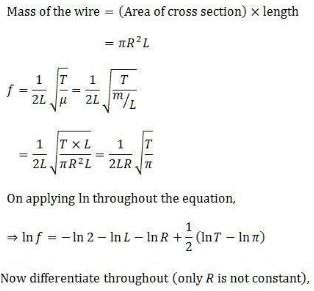
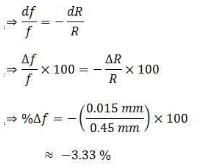


Chapter doubts & questions for Waves - Physics for JAMB 2025 is part of JAMB exam preparation. The chapters have been prepared according to the JAMB exam syllabus. The Chapter doubts & questions, notes, tests & MCQs are made for JAMB 2025 Exam. Find important definitions, questions, notes, meanings, examples, exercises, MCQs and online tests here.
Chapter doubts & questions of Waves - Physics for JAMB in English & Hindi are available as part of JAMB exam.
Download more important topics, notes, lectures and mock test series for JAMB Exam by signing up for free.
Physics for JAMB
259 videos|253 docs|230 tests
|

Contact Support
Our team is online on weekdays between 10 AM - 7 PM
Typical reply within 3 hours
|
Free Exam Preparation
at your Fingertips!
Access Free Study Material - Test Series, Structured Courses, Free Videos & Study Notes and Prepare for Your Exam With Ease

 Join the 10M+ students on EduRev
Join the 10M+ students on EduRev
|

|
Create your account for free
OR
Forgot Password
OR
Signup to see your scores
go up within 7 days!
Access 1000+ FREE Docs, Videos and Tests
Takes less than 10 seconds to signup

